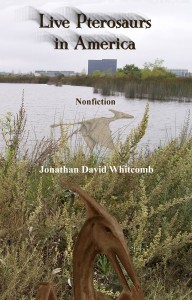I’ve written elsewhere about this paleontologist, about his extensive criticism of the concept of modern living pterosaurs (“Pterosaurs alive in, like, the modern day”). His lengthy writings, on that one page, about questionable reports—they ring like strawman arguments to me, for the credible accounts are entirely neglected by Darren Naish. I appreciate his worthy contributions to paleontology, especially in regard to pterosaur fossils; but it seems to me that he has gone far afield in wandering into cryptozoology, and he seems unaware of how serious investigations of living pterosaurs are actually progressing.
I now comment on part of a comment (by Cameron, #12) on that blog by Naish. It is dated December 24, 2007.
Mr. Whitcomb, who frequents the cryptozoology.com forum as “jdw”, now claims that there are pterosaurs in…South Carolina. Considering how many bird enthusiasts there are in this country who seem to be able to spot anything slightly unusual or out of range, that would have to be one heckofa stealthy pterosaur.
The South Carolina pterosaur sighting was by Susan Wooten, who has maintained the truthfulness of her testimony for years. The description of that giant flying creature, seen in daylight near a swamp, is hardly unique in North America, but let’s examine Cameron’s statement, to see what he insinuates and if he reasons well. We need clear thinking.
Indeed we have many bird-watchers in the United States; I presume South Carolina is no exception. Watching birds is a popular hobby, but what is entailed? Well . . . watching birds and reporting those birds. So what does that tell us about a potential sighting of a giant Rhamphorhynchoid pterosaur? Well . . . nothing.
What would I do, if I were a bird-watcher who saw a giant long-tailed pterosaur? I would certainly not bother trying to look up “pterodactyl” on my report form. But what would a typical bird-watcher do? Cameron seems to have missed something important here, for bird-watchers, every one of them, are quite human. Think about it: Who wants to be called “crazy?” Who wants to be ostracized?
Have I missed something here? Cameron commented on a sighting in South Carolina and seems to have dismissed it because it was of a large pterosaur. If a bird-watcher were brave enough to report that (and who is Cameron to declare that no bird-watcher has ever done so?) why would the general public react much differently? What’s wrong with the eyewitness who actually did report that sighting in South Carolina? Why should she be a bird-watcher?
Cameron seems to have dismissed the South Carolina pterosaur sighting with, “That would have to be one heckofa stealthy pterosaur.” What is really wrong with a living creature being extremely stealthy? If it lived in a country where almost every human believed it was extinct, that creature could fly around near a swamp on rare occasions. If it was a somewhat rare nocturnal creature, it would be much easier to go unclassified except as a cryptid. And how many hunters hunt pterosaurs in any swamp? And in which swamp would they look? And what tree would they climb in that swamp? It would be a challenging hunt, for a flying creature might never leave any footprint in a swamp.
Of course Cameron may not have intended any negative reflection on Susan Wooten, but I am grateful that his comment gave me an opportunity to bring up a kind of assumption that critics don’t seem to realize is an assumption: Lack of news reports of living pterosaurs does not mean that nobody sees apparent living pterosaurs.
I don’t know if that apparent ropen was startled out of a daytime sleep and forced into the air that day in South Carolina; I suspect it was. I don’t know if it is part of a colony in that part of North America or if it happened to have wandered away from tropical Central America. I don’t know if it is extremely stealthy or just somewhat rare and almost always nocturnal. I do know, as a former forensic videographer, experienced in judging the credibility of many eyewitnesses, that Susan Wooten is a credible eyewitness. I believe she saw something at least similar to a ropen. And I believe that the ropen is a modern living pterosaur.
Advertisement
 Live Pterosaurs in America, by Jonathan David Whitcomb, is a nonfiction book in the true genre of cryptozoology. Read the astonishing accounts in the words of the eyewitnesses themselves. Sightings are examined in detail, and they are from many states, including California, Texas, Arkansas, Florida, Georgia, South Carolina, Ohio, Michigan, Kansas, and other states. This book has sold better than any other cryptozoology book about living pterosaurs, on Amazon.com from late 2009 through mid-2010.
Live Pterosaurs in America, by Jonathan David Whitcomb, is a nonfiction book in the true genre of cryptozoology. Read the astonishing accounts in the words of the eyewitnesses themselves. Sightings are examined in detail, and they are from many states, including California, Texas, Arkansas, Florida, Georgia, South Carolina, Ohio, Michigan, Kansas, and other states. This book has sold better than any other cryptozoology book about living pterosaurs, on Amazon.com from late 2009 through mid-2010.
Please support living-pterosaur investigations by purchasing this book about amazing eyewitness accounts of pterosaurs in many parts of the United States over many years.
For some teenagers and pre-teens, this book on living pterosaurs is a sure cure for boredom, with accounts of interviews done by both old and young American cryptozoologists, including one of the age of only twelve years.




